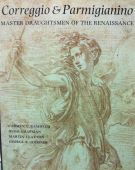Correggio and Parmigianino Master Draughtsmen of the Renaissance
| Author(s) | Carmen C. Bambach, Hugo Chapman, Martin Clayton, George R. Goldner, | ||
| Editor | British Museum Press | Place | Londra |
| Year | 2000 | Pages | 192 |
| Measure | 23x29 (cm) | Illustration | 190 ill. a colori e b/n n.t. - colors and b/w ills |
| Binding | cart. edit. con sovracc. ill. colori - Hardcover with dustjacket | Conservazione | Usato ottime condizioni - used very good |
| Language | Inglese - English text | Weight | 1500 (gr) |
| ISBN | 0714126284 | EAN-13 | 9780714126289 |
not available
Bringing together works from numerous important collections on both sides of the Atlantic, this catalogue presents a broad survey of Correggio and Parmigianino, with all the drawings illustrated in colour.
The catalogue reinforces a tendency to view these not-quite-contemporary Parmese artists in an almost binary opposition, repeating conventional wisdom that describes Correggio’s drawings as beautiful but utilitarian, while designating Parmigianino as a consummate draughtsman. A. E. Popham framed this same idea more adroitly in the opening pages of his still indispensable Correggio’s Drawings (London: The British Academy, 1957), categorizing Correggio as a “painter-artist…less likely to be interested in the process of constructing a picture and…preserving these steps in its construction” (1). Correggio, by implication, drew only when required: The act of drawing was a limited means to an end, of less import as intellectual process than the creative moments that occurred during facture of the culminating work, usually a painting. By contrast, Parmigianino’s prolificacy suggests an internal kunstwollen and personal imperative, drawing for its own sake because “linear rhythm, the feel of pen and ink…were a joy and [he] was never happier than when, to use a current phrase, doodling…. Correggio never doodled” (2). Parmigianino’s “doodles” are thus construed as signaling intellectual impulses distinct from Correggio’s more spontaneously combustive art, a dichotomy operative only in a universe that tacitly privileges Giorgio Vasari’s model of disegno, where drawing is paramount to the process of pictorial construction.
Recommended books...





